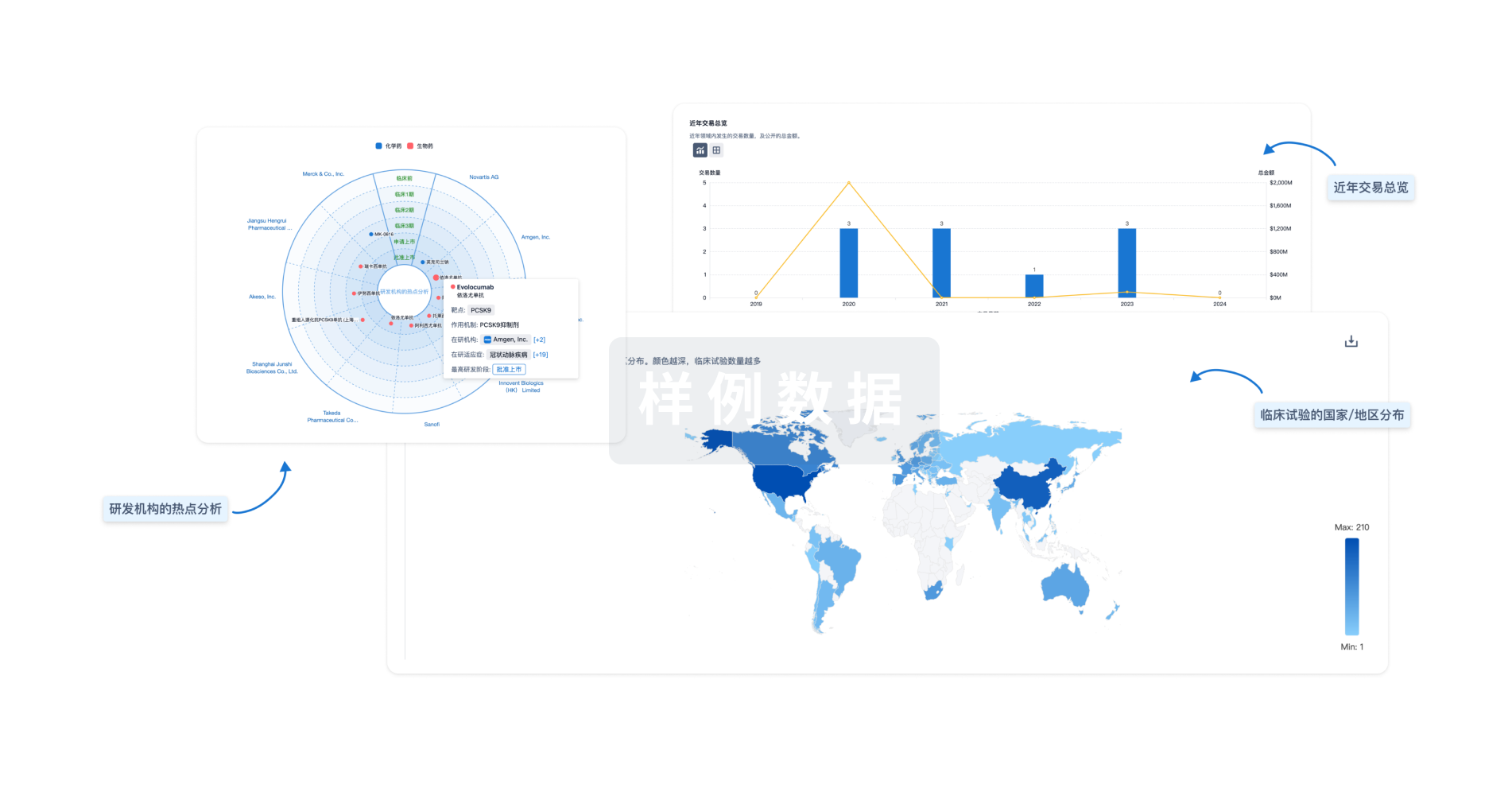预约演示
更新于:2025-05-07
MSMO1
更新于:2025-05-07
基本信息
别名 C-4 methylsterol oxidase、DESP4、ERG25 + [4] |
简介 Catalyzes the three-step monooxygenation required for the demethylation of 4,4-dimethyl and 4alpha-methylsterols, which can be subsequently metabolized to cholesterol (PubMed:21285510, PubMed:23583456, PubMed:26114596, PubMed:28673550). Also involved in drug metabolism, as it can metabolize eldecalcitol (ED-71 or 1alpha,25-dihydroxy-2beta-(3-hydroxypropoxy)-cholecalciferol), a second-generation vitamin D analog, into 1alpha,2beta,25-trihydroxy vitamin D3; this reaction occurs via enzymatic hydroxylation and spontaneous O-dehydroxypropylation (PubMed:26038696). |
关联
2
项与 MSMO1 相关的药物靶点 |
作用机制 MSMO1 inhibitors |
在研适应症 |
非在研适应症- |
最高研发阶段临床前 |
首次获批国家/地区- |
首次获批日期1800-01-20 |
靶点 |
作用机制 MSMO1 inhibitors |
在研机构- |
在研适应症- |
非在研适应症 |
最高研发阶段终止 |
首次获批国家/地区- |
首次获批日期1800-01-20 |
100 项与 MSMO1 相关的临床结果
登录后查看更多信息
100 项与 MSMO1 相关的转化医学
登录后查看更多信息
0 项与 MSMO1 相关的专利(医药)
登录后查看更多信息
179
项与 MSMO1 相关的文献(医药)2025-06-01·Toxicon
The DHCR7 is the key target of lipotoxic liver injury caused by matrine through abnormal activation of the cholesterol synthesis pathway
Article
作者: Li, Jiaqi ; Zhang, Wenting ; Tao, Xiaoyu ; Li, Zhiqi ; Zhao, Chongjun ; Fan, Qiqi ; Gao, Yifei ; Chen, Linzhen ; Wu, Jiarui ; Lu, Shan
2025-04-11·Investigative Ophthalmology & Visual Science
Treatment of Pathological Lymphangiogenesis via Circular RNA-Mediated Cholesterol Metabolism Remodeling
Article
作者: Jiang, Qin ; Zhang, Ziran ; Mu, Wan ; Shi, Lianjun ; Yan, Biao ; Ye, Fan ; Liu, Qian ; Li, Xiumiao ; Lu, Shuting
2025-03-01·Poultry Science
Integrated metabolome and transcriptome analysis reveals key genes and pathways associated with egg yolk percentage in chicken
Article
作者: Luo, Yuxing ; Zhu, Shoujia ; Zhao, Xuli ; Ning, Zhonghua ; Wang, Mengyuan ; Li, Wen
4
项与 MSMO1 相关的新闻(医药)2024-02-23
·药明康德
▎药明康德内容团队编辑 肿瘤细胞无时无刻不与其所处的营养、代谢、免疫等各种应激环境相互作用,这决定了肿瘤细胞的存活、增殖或死亡。近些年来,铁死亡(Ferroptosis)逐渐引起了肿瘤领域研究的关注,它是一种铁依赖的磷脂过氧化驱动的新型细胞死亡形式。在铁离子以及细胞中的ROS或在酯氧合酶的直接作用下,细胞膜上的磷脂会发生脂质过氧化,从而导致细胞功能受损以及死亡。不过,为了防止脂质过氧化物的过量积累导致铁死亡的发生,细胞内部也存在许多抵抗铁死亡的机制。这些机制在正常情况下可以保护细胞的功能,但一旦被肿瘤“学习”,则可能会成为肿瘤逃避死亡的策略,因此了解铁死亡对研发肿瘤疗法的靶向策略有重大意义。在日前《自然》杂志中,有两篇论文背靠背揭示了全新的铁死亡调控机制。其中一项研究来自同济大学医学院/附属第十人民医院王平团队,新研究揭示了远端胆固醇合成通路关键酶能通过调控7-脱氢胆固醇(7-DHC)的水平差异来影响铁死亡敏感性,而靶向调控7-DHC的水平有望成为癌症和缺血再灌注器官损伤的治疗策略。实验中,研究团队通过诱导剂使细胞发生铁死亡,同时他们使用了全基因组的CRISPR敲除筛选,探索铁死亡发生时有哪些关键的调控基因。结果显示,除了已知的铁死亡关键调控基因之外,研究发现远端胆固醇合成通路的关键基因,分别在抑制和促进铁死亡组中发生了富集。例如远端胆固醇合成通路关键基因MSMO1、CYP51A1、EBP和SC5D的敲除能够促进铁死亡的发生;而DHCR7的敲除则会抑制铁死亡的发生,其编码的7-脱氢胆固醇还原酶参与着远端胆固醇合成途径,也会调节7-DHC的水平。研究后续实验也证实,全新发现的这条铁死亡途径依赖于7-DHC水平进行调控。从生化途径来看,7-DHC是胆固醇合成的中间甾醇,由巯基甾醇5-去饱和酶(SC5D)催化产生,并在7DHCR7的催化下转化成为胆固醇。作者在细胞水平上验证了7-DHC是一种全新的内源铁死亡抑制因子,能够以自身的氧化为代价直接抑制磷脂过氧化的发生,并依赖其B环中的5,7-不饱和双键。作者也发现7-DHC存在于细胞质膜与线粒体中,为7-DHC直接发挥抑制磷脂过氧化的功能提供了空间基础。▲研究鉴定出全新铁死亡调控机制(图片来源:研究团队提供)作者指出,这一新发现能从两方面带来全新的治疗策略,第一种是通过诱导铁死亡发生来治疗肿瘤,第二种能通过抑制铁死亡来保护器官,帮助解决器官缺血再灌注损伤疾病。在肿瘤治疗方面,作者发现抑制人弥漫大B淋巴瘤细胞中7-DHC的产生,能够直接诱导铁死亡的发生,而小鼠水平的成瘤实验也证明靶向抑制7-DHC的产生能够在体诱导肿瘤细胞铁死亡并抑制肿瘤的生长。另一方面,通过药理学靶向抑制DHCR7可以有效在体积累7-DHC并治疗小鼠缺血再灌注肾损伤。这也提示远端胆固醇合成通路作为治疗肿瘤及缺血再灌注肾损伤的新靶点。▲7-DHC水平的提升可以帮助细胞避免铁死亡(图片来源:研究团队提供)在另一篇《自然》论文中,来自德国维尔茨堡大学的José Pedro Friedmann Angeli教授团队同样发现癌细胞能利用7-DHC来调节铁死亡过程,从而保证自己的存活。此外,7-DHC的累积能够增加癌细胞的适应性,使它们变得更具侵袭性。该研究同样通过基因筛选流程发现了DHCR7基因可以促进铁死亡的发生,并且找到了7-DHC这种特殊的铁死亡调控分子。当癌细胞不断累积7-DHC时,它们的存活能力会显著上升,原因在于7-DHC对过氧自由基有着强大的反应性,因此能保护细胞膜磷脂分子免受自氧化和断裂,阻止细胞破裂死亡。▲7-DHC累积会让肿瘤生长更旺盛(图片来源:参考资料[2])在神经母细胞瘤和伯基特淋巴瘤模型中,作者尝试提升了癌细胞7-DHC的水平,随着7-DHC不断在细胞内累积,癌细胞开始逐渐转变成了抗磷脂过氧化的状态,可以轻而易举地逃避铁死亡,最终演变成生长更快,更具侵袭性的类型。此外,研究者也指出,我们需要对现有的一些药物使用更加谨慎,比如那些能够抑制DHCR7的药物。患者在服用这些药物后会提升血液中7-DHC的水平,这对癌细胞来说是喜闻乐见的,未来我们需要更多研究来分析两者之间是否具有关联性,减少药物的副作用。同济大学医学院/附属第十人民医院王平教授为第一篇论文的通讯作者。同济大学医学院博士后李亚旭、博士研究生冉巧、博士后段秋慧和同济大学附属第十人民医院研究员金佳丽为该论文共同第一作者。该研究同时得到了斯隆凯特琳癌症中心姜学军教授、中科院药物所周虎教授/朱瑱韵老师、中科院营养所/香港城市大学尹慧勇教授/陈欣、上海交通大学医学院附属新华医院陈世礼博士、中科院营养所翟琦巍教授/王汇博士和同济大学附属第十人民医院秦环龙教授等团队的合作和大力支持。该研究也得到了同济大学邱安东教授、李永勇教授、北京大学王初教授、四川大学张祯威教授及中科院上海生化与细胞所王红艳教授等提供的技术指导。本项研究获得了国家自然科学基金委国际合作项目、重点项目以及科技部国家重点研发计划等项目的资助。参考资料:[1] Li, Y., Ran, Q., Duan, Q. et al. 7-Dehydrocholesterol dictates ferroptosis sensitivity. Nature (2024). https://doi.org/10.1038/s41586-023-06983-9[2] Freitas, F.P., Alborzinia, H., dos Santos, A.F. et al. 7-Dehydrocholesterol is an endogenous suppressor of ferroptosis. Nature (2024). https://doi.org/10.1038/s41586-023-06878-9本文来自药明康德内容微信团队,欢迎转发到朋友圈,谢绝转载到其他平台。如有开设白名单需求,请在“学术经纬”公众号主页回复“转载”获取转载须知。其他合作需求,请联系wuxi_media@wuxiapptec.com。免责声明:药明康德内容团队专注介绍全球生物医药健康研究进展。本文仅作信息交流之目的,文中观点不代表药明康德立场,亦不代表药明康德支持或反对文中观点。本文也不是治疗方案推荐。如需获得治疗方案指导,请前往正规医院就诊。更多推荐点个“在看”再走吧~
临床研究
2024-02-15
·精准药物
撰文丨王聪编辑丨王多鱼排版丨水成文铁死亡(Ferroptosis)是2012年由哥伦比亚大学 Brent Stockwell 实验室发现的一种受调控的坏死性细胞死亡方式,特征是铁依赖性脂质过氧化物的积累,其形态特征、作用方式及分子机制与其他程序性死亡方式(例如凋亡、焦亡、程序性坏死等)截然不同。细胞中有着多个内源性防御途径来对抗铁死亡,包括GSH-GPX4、FSP1-CoQ1、DHODH-CoQ10、GCH1-BH4,以及纪念斯隆凯特琳癌症中心姜学军团队发现的MBOAT1/2。由于其在癌症、神经退行性疾病和器官缺血再灌注损伤等多种病理生理条件中的关键作用,铁死亡正在受到越来越多的关注。2024年1月31日,同济大学医学院/附属第十人民医院王平教授团队(李亚旭、冉巧、段秋慧、金佳丽为共同第一作者)在 Nature 期刊发表了题为:7-Dehydrocholesterol dictates ferroptosis sensitivity 的研究论文。该研究发现并揭示了远端胆固醇合成通路关键酶通过调控7-脱氢胆固醇(7-DHC)的水平来调控铁死亡敏感性的机制,表明了通过药物调控7-DHC水平,是一种有前途的治疗癌症和缺血再灌注损伤的新策略。王平教授王平,同济大学医学院/附属第十人民医院教授、博士生导师,同济大学医学院副院长,课题组主要研究肿瘤微环境调控机制与靶向,还在转化研究领域积极拓展,包括药物筛选、肿瘤免疫标志物筛选以及肿瘤免疫细胞的应用与转化等。7-脱氢胆固醇(7- Dehydrocholesterol,7-DHC),是胆固醇生物合成途径的代谢中间体,其由C5-甾醇去饱和酶(SC5D)合成,并被7-DHC还原酶(DHCR7)代谢用于胆固醇合成。作为一种不饱和甾醇,7-DHC在其B环中含有一个5,7-二烯,可作为脂肪酸过氧化物自由基的强效氢原子供体。到目前为止,除了7-DHC衍生的氧化胆固醇对神经元和视网膜细胞具有细胞毒性外,7-DHC的生物学作用我们还不清楚。在这项研究中,研究团队使用全基因组CRISPR-Cas9筛选,发现了参与远端胆固醇生物合成的酶在调控铁死亡方面具有关键而又截然相反的作用。具体来说,细胞通过控制7-DHC的水平来调控铁死亡,MSMO1、CYP51A1、EBP和SC5D是铁死亡的潜在抑制因子,而DHCR7则是一种铁死亡的促进因子。从机制上讲,7-DHC通过使用共轭二烯发挥其抗磷脂自氧化功能来控制铁死亡的监测,并保护血浆和线粒体膜免受磷脂自氧化的影响。重要的是,通过药物靶向EBP阻断内源性7-DHC的生物合成,可以诱导铁死亡并抑制肿瘤生长,而通过抑制DHCR7来增加7-DHC水平,则有效促进了癌症转移和减缓了肾脏缺血再灌注损伤的进展,支持了远端胆固醇合成通路在体内的关键功能。该研究揭示了7-DHC作为一种天然的抗铁死亡代谢物的作用及机制,并表明了通过药物调控7-DHC水平,是一种有前途的治疗癌症和缺血再灌注损伤的新策略。值得一提的是,维尔茨堡大学的研究人员同期在 Nature 期刊发表了题为:7-Dehydrocholesterol is an endogenous suppressor of ferroptosis 的研究论文。该研究揭示了7-DHC是铁死亡的内源性抑制性因子,证明了7-DHC的积累能够诱导肿瘤向铁死亡抵抗状态转变,导致癌细胞逃逸铁死亡,产生更具侵袭性的表型。众所周知,高胆固醇水平与心血管疾病和糖尿病等健康问题有关,但大多数研究都集中于探索胆固醇是如何导致这些疾病的。这两项发表在 Nature 的新研究表明,胆固醇前体7-DHC作为一种抗氧化剂保护细胞免受铁死亡,这为改善癌症、缺血再灌注损伤等铁死亡相关疾病的治疗方法开辟了新道路。例如,阻断7-DHC合成和积累的药物,可能对某些癌症的治疗产生积极作用。此外,美国FDA曾批准了一些抑制DHCR7酶的药物,例如曲唑酮,用于治疗抑郁症,由于其导致嗜睡的副作用,甚至被用来治疗失眠。使用曲唑酮的人,血浆中的7-DHC水平会升高。而这两项新研究显示,高水平的7-DHC会促进癌症转移,因此,有必要调查曲唑酮使用者的癌症发病率以及转移情况。论文链接:https://www.nature.com/articles/s41586-023-06983-9https://www.nature.com/articles/s41586-023-06878-9声明:发表/转载本文仅仅是出于传播信息的需要,并不意味着代表本公众号观点或证实其内容的真实性。据此内容作出的任何判断,后果自负。若有侵权,告知必删!长按关注本公众号 粉丝群/投稿/授权/广告等请联系公众号助手 觉得本文好看,请点这里↓
临床研究
2024-02-01
·今日头条
本文为转化医学网原创,转载请注明出处
作者:Sophia
导读:
铁死亡是一种由铁依赖性磷脂过氧化驱动的调节性细胞死亡形式,与多种疾病有关,包括癌症退行性疾病4和器官缺血再灌注损伤(IRI)。
2024年1月31日,同济大学医学院/附属第十人民医院王平教授团队(李亚旭、冉巧、段秋慧、金佳丽为共同第一作者)在 《Nature 》期刊发表了题为“7-Dehydrocholesterol dictates ferroptosis sensitivity”的研究论文。
研究发现并揭示了远端胆固醇合成通路关键酶通过调控7-脱氢胆固醇(7-DHC)的水平来调控铁死亡敏感性的机制,表明了通过药物调控7-DHC水平,是一种有前途的治疗癌症和缺血再灌注损伤的新策略。
https://www.nature.com/articles/s41586-023-06983-9
研究背景
01
铁死亡是一种独特的调节细胞死亡方式,由于其在各种病理生理状况(包括癌症、神经退行性疾病4和器官 IRI)中的关键作用而引起了广泛关注。铁死亡的一个关键标志是铁依赖性磷脂过氧化,这会导致膜损伤。细胞具有内在的防御系统,可以保护自己免受磷脂过氧化。半胱氨酸/胱氨酸-GSH-谷胱甘肽过氧化物酶 4 (GPX4) 轴是通过将磷脂氢过氧化物解毒为磷脂醇来抑制铁死亡的主要途径。
7-脱氢胆固醇(7- Dehydrocholesterol,7-DHC),是胆固醇生物合成途径的代谢中间体,其由C5-甾醇去饱和酶(SC5D)合成,并被7-DHC还原酶(DHCR7)代谢用于胆固醇合成。作为一种不饱和甾醇,7-DHC在其B环中含有一个5,7-二烯,可作为脂肪酸过氧化物自由基的强效氢原子供体。到目前为止,
除了7-DHC衍生的氧化胆固醇对神经元和视网膜细胞具有细胞毒性外,7-DHC的生物学作用我们还不清楚。
研究结果
02
在这项研究中,研究团队使用全基因组CRISPR-Cas9筛选,发现了参与远端胆固醇生物合成的酶在调控铁死亡方面具有关键而又截然相反的作用。具体来说,细胞通过控制7-DHC的水平来调控铁死亡,MSMO1、CYP51A1、EBP和SC5D是铁死亡的潜在抑制因子,而DHCR7则是一种铁死亡的促进因子。从机制上讲,7
-DHC通过使用共轭二烯发挥其抗磷脂自氧化功能来控制铁死亡的监测,并保护血浆和线粒体膜免受磷脂自氧化的影响。重要的是,通过药物靶向EBP阻断内源性7-DHC的生物合成,可以诱导铁死亡并抑制肿瘤生长,而通过抑制DHCR7来增加7-DHC水平,则有效促进了癌症转移和减缓了肾脏缺血再灌注损伤的进展,支持了远端胆固醇合成通路在体内的关键功能。
总之,我们的研究揭示了 7-DHC 作为天然抗铁性代谢物的作用,并表明 7-DHC 水平的药理学操作是一种很有前途的癌症和 IRI 治疗策略。
研究意义
03
本研究,我们提供了明确的证据,
证明7-DHC是一种有效的抗铁沉降代谢物。7-DHC通过转移磷脂的过氧化途径,保护细胞免受质膜和线粒体上的磷脂过氧化,从而减轻铁死亡。
我们发现麦角甾醇是酿酒酵母中发现的 7-DHC 的类似物,也可以抑制铁死亡。据推测,这些不饱和甾醇共有的共同化学性质,特别是它们对共轭二烯的占有,使自由基捕获能够抑制铁死亡。我们的研究还表明,不同脂质(如磷脂和甾醇)的过氧化在铁死亡过程中可能具有不同的功能。此外,有必要进一步研究通过氧化和其他化学衍生的 7-DHC 的各种代谢物是否参与铁死亡调节。
重要的是,我们的研究具有很强的治疗意义。我们提供了令人信服的证据表明,
抑制 7-DHC 生物合成是治疗癌症的潜在策略,尤其是那些具有高水平 7-DHC 或 DHCR7 突变的癌症,例如伯基特淋巴瘤。
我们的研究还表明,
通过药理学抑制 DHCR7 来提高 7-DHC 水平可能会改善 IRI 患者的临床结果。
由于一组 FDA 批准的药物已被证明可以抑制 DHCR7,因此这种可能性很容易在临床环境中测试,用于治疗慢性 IRI 患者。
参考资料:
https://www.nature.com/articles/s41586-023-06983-9
注:本文旨在介绍医学研究进展,不能作为治疗方案参考。如需获得健康指导,请至正规医院就诊。
热门·直播/活动
🕓 上海|3月01日-02日
▶第三届长三角单细胞组学技术应用论坛暨空间组学前沿论坛将在上海召开,诚邀您的参与!
点击对应文字 查看详情
临床研究
分析
对领域进行一次全面的分析。
登录
或

生物医药百科问答
全新生物医药AI Agent 覆盖科研全链路,让突破性发现快人一步
立即开始免费试用!
智慧芽新药情报库是智慧芽专为生命科学人士构建的基于AI的创新药情报平台,助您全方位提升您的研发与决策效率。
立即开始数据试用!
智慧芽新药库数据也通过智慧芽数据服务平台,以API或者数据包形式对外开放,助您更加充分利用智慧芽新药情报信息。
生物序列数据库
生物药研发创新
免费使用
化学结构数据库
小分子化药研发创新
免费使用
